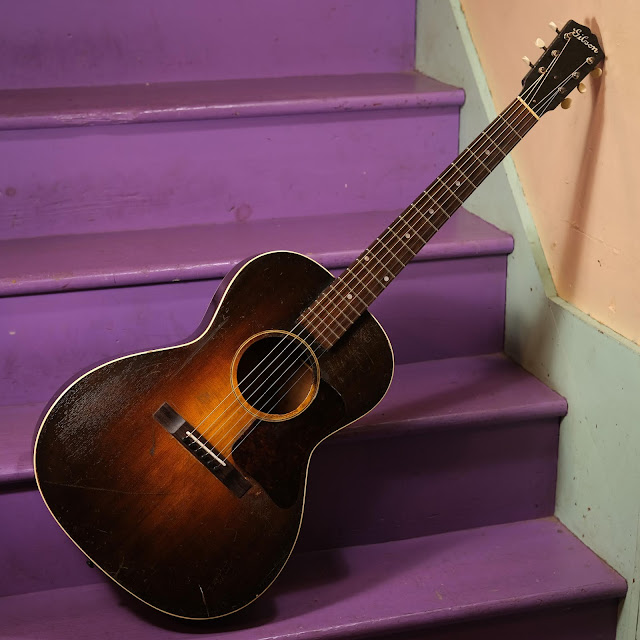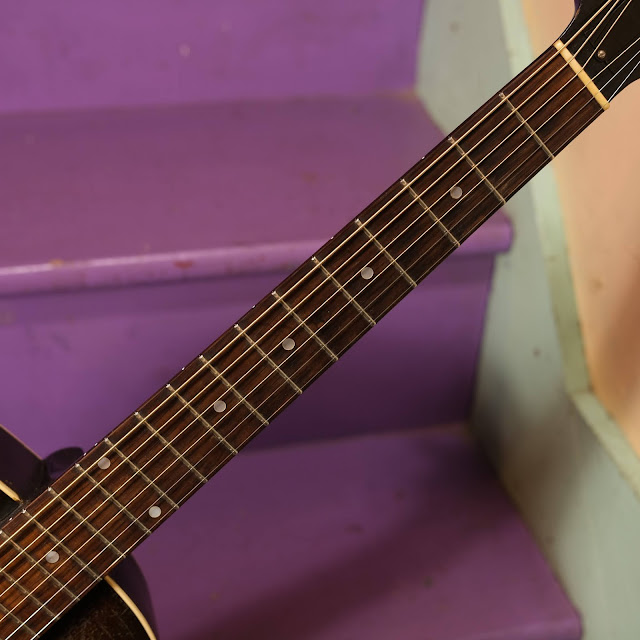1932 Gibson L-1 (Fancy L-00) Flattop Guitar
Well, this old box (factory order number 298 says it's a '32) is a hum-dinger. It's sure of itself and powerful. This version of the L-1 model is basically a gussied-up 14-fret L-00 from the same time, but with back binding, an elevated fretboard extension, and "Cremona brown"-burst finish. Oh -- and it has that dot at the 15th fret, too.
Inside, the bracing is light but sturdy, so unlike a same-period Martin this thing will be a little less weather-unstable as the seasons change. Still, the top has doming/belly like any old Gibson -- not extreme, but it's there. Someone pointed some belly out to me on a '60s Gibson, recently, and I'd realized that I've grown so used to old guitars that I don't even think to mention it anymore!
It sound is excellent -- plainspoken, loud, punchy, woody, thick in the lower-mids, and clear throughout. It's very fundamental and has good sustain, but at the same time it's very "round." It's not as barky or aggressive as slightly-later L-00-style guitars can be. It's basically the perfect old-time guitar -- flatpicking, fingerpicking, you name it -- it sounds good and full, but clear.
This one had some hurdles to jump repair-wise, but now that it's done-up it's stable, plays beautifully, looks grand, and is practical and ready to go.
Repairs included: a neck reset, repair to a split heel, cleats/crack repairs to the top, reglue of back braces, a fret level/dress, tuner swap (correct period tuners and 3 years younger, but not original -- the originals would've been nickel-plated of the same), new rosewood bridge (styled on the missing original, but drop-in saddle and 1/8" wider overall), new endpin and bridge pins, general cleaning, and setup.
Setup notes: the neck is straight, the truss rod works, and action is perfect/fast at 3/32" EA and 1/16" DGBE at the 12th fret. Strings are 54w, 40w, 30w, 22w, 16, 12 -- a regular "lights" set with the middle strings lightened up a gauge or two. The guitar is lightly-built so it doesn't need a ton of tension to get it singing.
Scale length: 24 7/8"
Nut width: 1 3/4"
String spacing at nut: 1 1/2"
String spacing at bridge: 2 1/4"
Body length: 19 1/4"
Lower bout width: 14 3/4"
Waist width: 8 1/2"
Upper bout width: 10 1/8"
Side depth at endpin: 4 3/8"
Side depth at endpin: 4 3/8"
Top wood: solid spruce
Back wood: solid mahogany
Sides wood: solid mahogany
Sides wood: solid mahogany
Bracing type: x-braced
Fretboard: rosewood
Bridge: rosewood, bone saddle, ebony pins
Neck feel: medium V-shape, ~12" board radius (or just a hair shallower)
Neck wood: mahogany, bone nut
Neck wood: mahogany, bone nut
Condition notes: well, it has a split heel. I repaired that and then reset it and it's good to go, but it'd been repaired sloppily in the past and it was a bunch of fussy work to get it pat. It's not very obvious at a glance, too. The frets are in good order but lower than original (they're now about the height of fresh Gibson Kalamazoo frets from the period), there's some wear to the fretboard in first position, the bridge, saddle, and pins are all new replacements, and I added side dots to the neck. The tuners are not original but are correct for the guitar (this had one side of originals on it when it came in but they were damaged) and some of the ferrules are (vintage) replacements.
Also: There's a tiny hairline side crack near the endpin that's cosmetic and repaired. On the top there's a hairline (repaired) crack at the side of the pickguard, one (repaired) at the bass-waist, and one (repaired, very tight) below the bridge that's almost invisible. The new saddle is fairly tall but I know it will settle-in over the next couple days and I will need to take 1/32" off of it or so. When I reset the neck -- because I was also repairing the heel -- I wanted to make sure that the reset would last for many decades (if not for the guitar's life) into the future. The bridge is also not a faithful reproduction, but slightly wider (1/8") and with a drop-in saddle rather than through-cut. If you like the look of a through-cut, I can cut a saddle that is a "faux-through-cut" to suit, but I think the stability of drop-ins is very important on a player's guitar. When I set the neck and installed the bridge, I aligned it via the original pin-holes. Because of that, the strings are slightly off-center over the soundhole. Gibson!
Also: the finish is all-original throughout and has all the usual lots-of-scratches, small nicks and dings, tiny scuffs, and weather-checking/wear-and-tear you might expect. The soundhole had some old pickwear on its treble edge and someone brushed a sealer coat over just that area some time in the distant past. OH, and the pearl dot at the 15th fret is a replacement.
It comes with: a foam/flight "hard" case.





























Comments